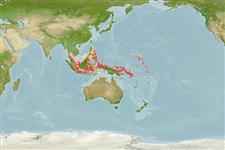>
Ophidiiformes (Cusk eels) >
Dinematichthyidae (Viviparous brotula)
Etymology: Diancistrus: Greek, di = two + Greek, agkistron = hook (Ref. 45335); altidorsalis: Name from Latin 'altus' meaning high and 'dorsalis' meaning neck, referring to its high-necked profile..
More on authors: Schwarzhans, Møller & Nielsen.
Environment: milieu / climate zone / depth range / distribution range
Sinh thái học
Biển Cùng sống ở rạn san hô; Mức độ sâu 15 - 20 m (Ref. 57884). Tropical
Sự phân bố
Các nước | Các khu vực của FAO | Các hệ sinh thái | Những lần xuất hiện | Point map | Những chỉ dẫn | Faunafri
Western Pacific: Indonesia, New Guinea, Sabah to the Solomons, including Sta. Cruz Islands.
Bộ gần gũi / Khối lượng (Trọng lượng) / Age
Maturity: Lm ? range ? - ? cm
Max length : 10.2 cm SL con đực/không giới tính; (Ref. 57884)
Short description
Hình thái học | Sinh trắc học
Các vây lưng mềm (tổng cộng): 76-85; Tia mềm vây hậu môn: 59 - 68; Động vật có xương sống: 43 - 45. Diagnosis: Vertebrae 11+32-34=43-45, dorsal fin rays 76-85, anal fin rays 59-68; eyes large (at least 2.5% SL); outer pseudoclasper large, broad, ear-lobe shaped; inner pseudoclasper a fleshy appendix at the anterior-inner rim of the outer pseudoclasper, without supporter; large scale patch on operculum above opercular spine (6–9 scales) and 1 to 3 isolated scales below opercular spine; head profile strongly ‘high-necked / hump-backed’; color yellow in live specimens (Ref. 57884).
Large dominating individuals were observed to make attacks toward smaller fish, which were hiding below rocks or any other shelter provided. One male was observed to flip backward the cover of the copulatory organ so that the organ can be exposed while swimming (Ref. 57884). Solitary inhabitant of coral reef crevices to at least 20m depth, cryptic (Ref 90102).
Life cycle and mating behavior
Chín muồi sinh dục | Sự tái sinh sản | Đẻ trứng | Các trứng | Sự sinh sản | Ấu trùng
Schwarzhans, W., P.R. Møller and J.G. Nielsen, 2005. Review of the Dinematichthyini (Teleostei, Bythitidae) of the Indo-West-Pacific. Part I. Diancistrus and two new genera with 26 new species. The Beagle, Records of the Museum and Art Galleries of the Northern Territory 21:73-163. (Ref. 57884)
IUCN Red List Status (Ref. 130435)
Threat to humans
Harmless
Human uses
Thêm thông tin
Age/SizeSự sinh trưởngLength-weightLength-lengthLength-frequenciesSinh trắc họcHình thái họcẤu trùngSự biến động ấu trùngBổ xungSự phong phúBRUVS
Các tài liệu tham khảoNuôi trồng thủy sảnTổng quan nuôi trồng thủy sảnCác giốngDi truyềnElectrophoresesDi sảnCác bệnhChế biếnNutrientsMass conversion
Các công cụ
Special reports
Download XML
Các nguồn internet
Estimates based on models
Preferred temperature (Ref.
123201): 27.9 - 29.3, mean 28.8 °C (based on 1452 cells).
Phylogenetic diversity index (Ref.
82804): PD
50 = 0.5000 [Uniqueness, from 0.5 = low to 2.0 = high].
Bayesian length-weight: a=0.00389 (0.00180 - 0.00842), b=3.12 (2.94 - 3.30), in cm total length, based on all LWR estimates for this body shape (Ref.
93245).
Mức dinh dưỡng (Ref.
69278): 3.4 ±0.5 se; based on size and trophs of closest relatives
Fishing Vulnerability (Ref.
59153): Low vulnerability (10 of 100).
